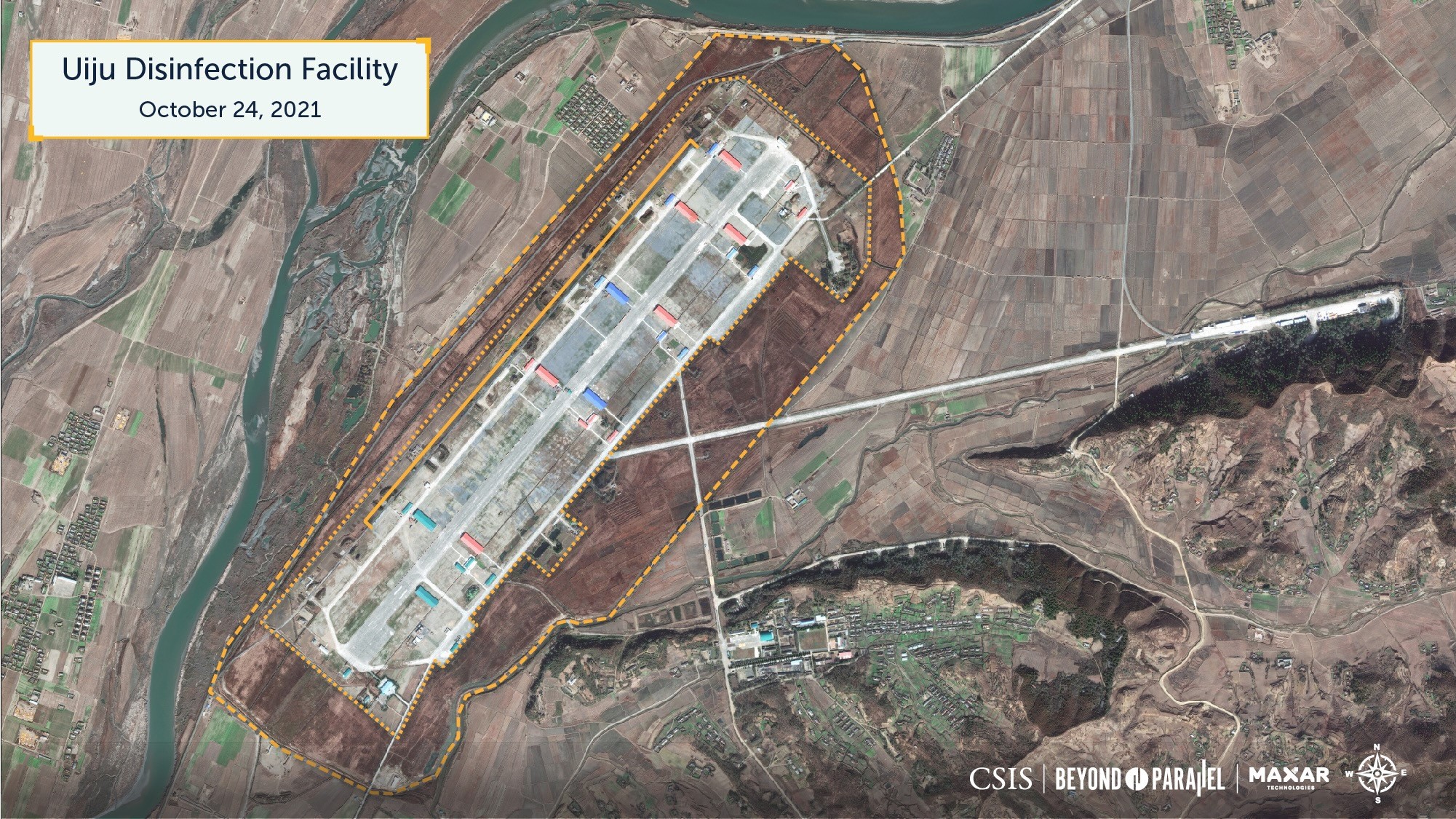
North Korea Attempting to Reverse COVID-19 Border Shutdown with Import Disinfection Facilities
As featured in Financial Times “North Korea building project points to reopening of border with China” on November 14, 2021.
Key Findings
- Over 16 months after shutdown of the border with China to prevent COVID transmission, North Korea has seen delays in its efforts to re-open commerce with its primary trade partner.
- A project to build a disinfection facility for cargo transport along the Sinuiju-Dandong border crossing started in early 2021 but is still incomplete. Smaller-scale disinfection facilities at other crossings appear to be in development.
- The conversion of Uiju Airbase into a disinfection facility started in early 2021, but the most recent satellite imagery as of November 12 shows no signs of being operational, indicating a delay of at least six months from its original opening plans.
- The significant infrastructure changes in and around the Uiju Airbase, including the construction of paved roads and warehouses, indicate that the new facility would be permanent and that it will be used as storage support for increased trade between China and North Korea after the need for disinfecting cargo subsides.
- An indicator of imminent border opening would be the resumption of railroad freight transportation with China and Russia in conjunction with these facilities.
- The border shutdown due to the absence of COVID vaccines and a dilapidated health infrastructure has placed tremendous pressure on the economy evident in rising prices, depleted reserves, and lack of basic supplies.
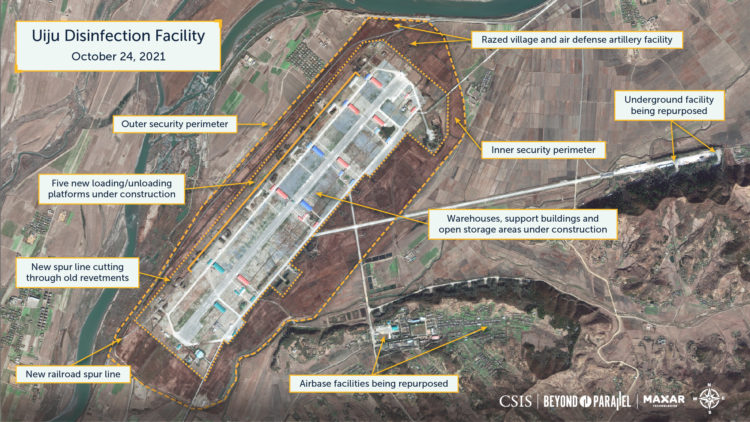
On March 3, 2021, North Korea adopted a “Law on Disinfection of Imports” to establish a “system and order of disinfecting imports at border-passing spots.” Concurrent with the passing of this law, North Korea began a major construction project to convert the Uiju Airbase into what has been described as a disinfection center to aid in the resumption of import and export operations at the nearby Sinuiju-Dandong border crossing with China. Among the first indications of this new construction project was transfer of what is believed to be the 24th Air Regiment equipped with IL-28/H-5 Beagle light bombers based at Uiju to the Changjin-up and Sondok Airbases between February 26 – 27, 2021.1
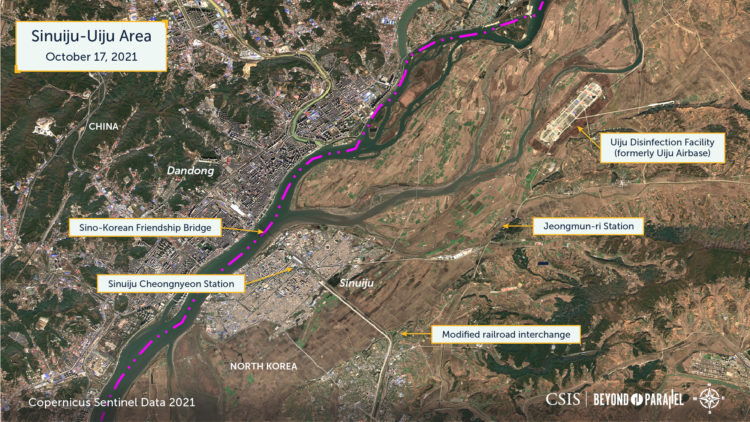

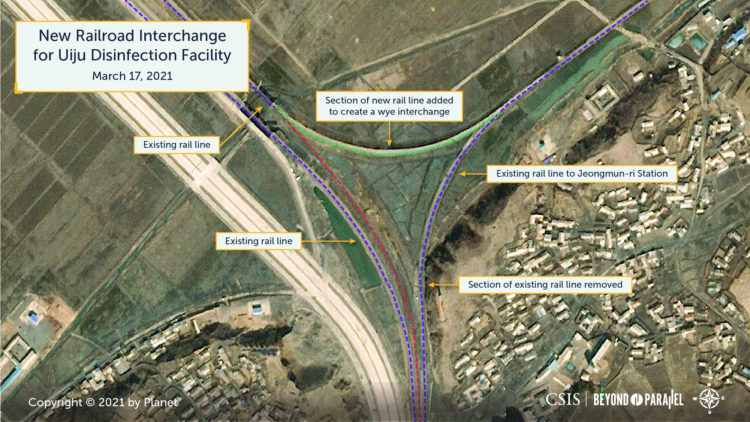
Among the early indications of the construction of a disinfection facility at the Uiju Airbase was work to modify an existing railroad interchange (40.083706, 124.436098) near the village of Yonsang-dong, approximately 4 kilometers south of Sinuiju, into a “wye” or triangular junction to ease the movement of rail traffic from Sinuiju to the soon-to-be-built facility and the turning of locomotives.2 This work began in February 2021 and was completed by early March. The modified railroad interchange was connected to an existing mainline running to the northeast, which passes through Jeongmun-ri Station (40.116672, 124.471919) and past the Uiju Airbase, approximately 8 kilometers to the northeast.
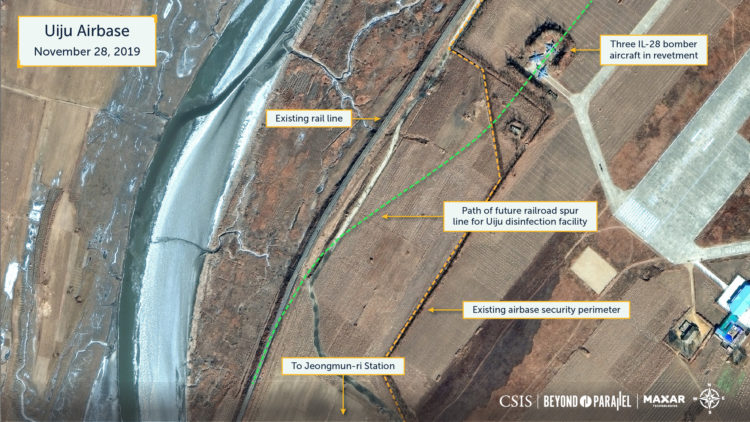

By March 17, a new industrial spur line had been constructed using concrete railroad ties. The new spur line branches from the mainline into the Uiju Airbase and runs directly through what were IL-28/H-5 light bomber aircraft revetments—a clear indication that the infrastructure changes to the airbase are permanent. The new spur line re-joins the existing mainline to the north of the airbase.
The spur line which serves the Uiju disinfection facility consists of only a single track indicating that any railcar classification would be undertaken at either the Sinuiju Cheongnyeon or Jeongmun-ri rail stations before arriving at the new facility. It also suggests that the level of traffic anticipated for the facility will initially be relatively light.
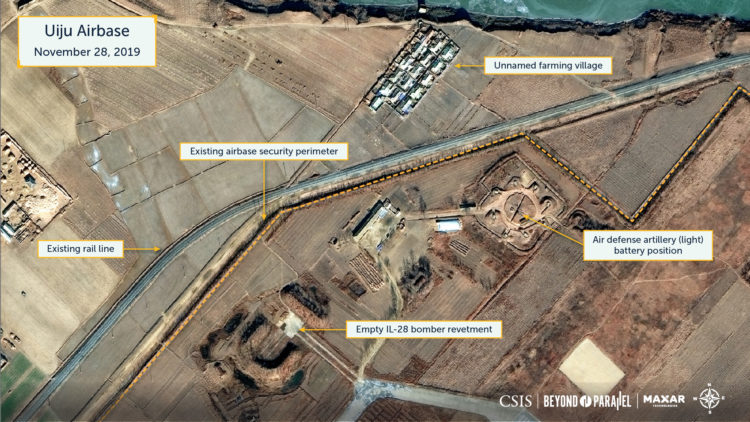


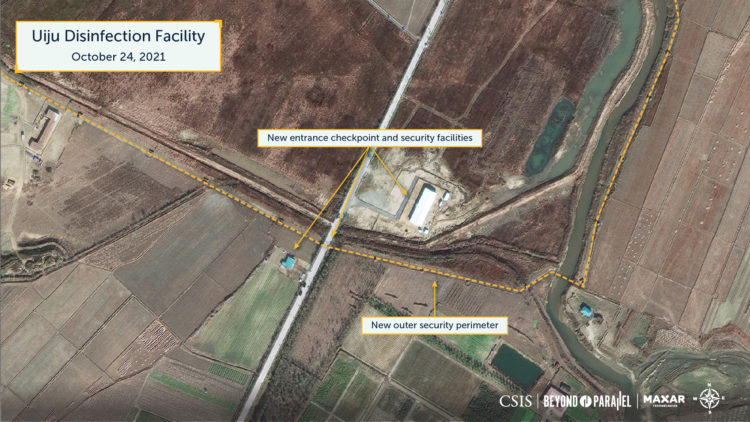
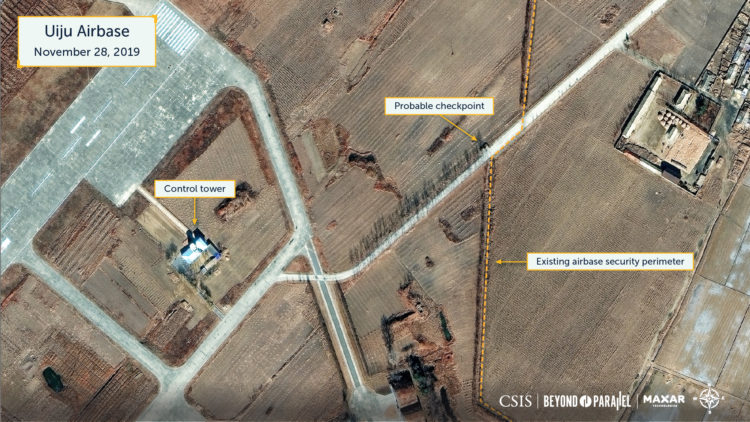
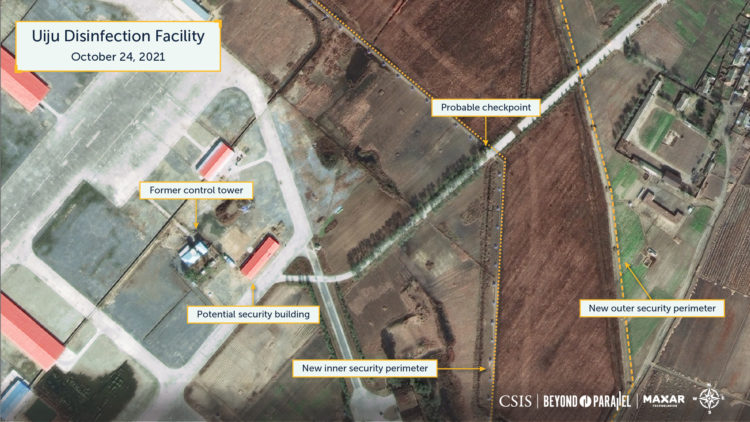
The new disinfection facility is notably encompassed by two new security perimeters. The outer perimeter measures approximately 7.9 kilometers long and encompasses approximately 3 square kilometers. A small village consisting of 16 homes (40.163649, 124.507007) as well as an air defense artillery battery position (40.162382, 124.508192) to the north of the base was razed to provide space for the outer perimeter. A second inner perimeter measures approximately 7.4 kilometers and encompassing approximately 1.7 square kilometers was also constructed, providing an additional layer of security for operations inside the facility. Along with these developments, checkpoints and security facilities are being added at the southern and northern road entrances.

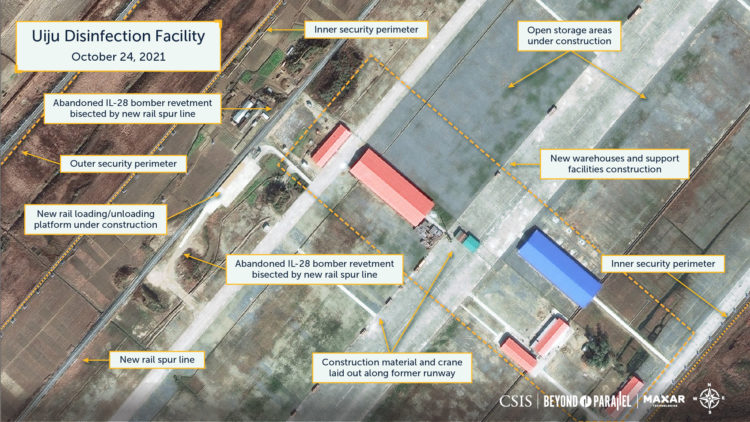
By mid-March, large sections of the ground adjacent to the runway were paved. Shortly afterwards, ten large warehouse-type buildings, each measuring about 2,700 square meters, were built. Additionally, a total of 18 smaller buildings, each measuring about 616 square meters, were also constructed near the large warehouses. These latter buildings will likely serve as administration and support buildings for the larger warehouses and overall operations. In total, the ten larger storage buildings provide a total of approximately 27,000 square meters of covered storage space, while the paved areas around them provide an additional 852,000 square meters of open storage space.
Other components of the former airbase, including the large underground aircraft hangar and headquarters facilities, are in the process of being repurposed—likely to serve the new disinfection facility.
To support rail operations at least five railroad loading/unloading platforms have been constructed along the new industrial spur line and adjacent to the warehouses on the west side of the facility.
Assessment
The current layout of the Uiju facility indicates that it will initially be used for the shipment, storage (in warehouses or open storage areas), and forwarding of bulk or dry cargo. As no washing facilities to disinfect the exterior of railcars have been identified any such operations will most likely take place as, or after, cargo is unloaded. At that point the interiors of the railcars could then be disinfected by hand as needed. The proximity of some of the smaller support buildings adjacent to the loading/unloading platforms suggests their potential use for screening, quarantining, or immunizing travelers.
Furthermore, the increased security in the perimeter and other permanent changes show that North Korea will continue to use the area after any need for a potential disinfection or quarantine facility subsides. Regardless of its ability to disinfect or quarantine, the center possesses all the characteristics of a rail transfer point and potentially an intermodal facility. Such infrastructure will support any increase in import and export volumes between North Korea and China in the future.
Satellite imagery collected between October 24 and November 12, 2021 show that construction at the facility continues and that it is not yet operational.
According to South Korea’s National Intelligence Service (NIS), North Korea sought to operate the disinfection center by April 2021.3 However, most recent satellite imagery shows continued construction and no signs of operations, indicating a further delay of at least six months after its original timeline. In a closed-door briefing on October 28, NIS is reported to have informed the intelligence committee of the Republic of Korea that North Korea is attempting to coordinate with China and Russia to resume railroad freight transportation.4 This coordination may indicate that the Uiju disinfection facility is close to becoming operational.
Other Locations
Private and public reports indicate that North Korea originally planned to operate small disinfection facilities at several other locations, including Kalma International Airport, Sunan International Airport, the ports of Nampo, Chongjin, Wonsan, Rason, and the Tumangang-Khasan railroad crossing.5 A review of satellite imagery of these locations during the past year, however, shows only minor activity at Nampo, Tumangang-Khasan border crossing, and Chongjin that may be related to minor disinfection facilities.
As previously reported by NK News, at Nampo, a building (38.736026, 125.433515) was constructed in the container port during the past year. The building covers approximately 5,600 square meters – an area more than twice the size of one of the large storage-type buildings at Uiju. Satellite imagery throughout the construction period show that the building is divided into numerous small rooms, which is not indicative of a storage unit for containers. Potentially, however, the building could be used for quarantining individuals. The location of the building would be an appropriate choice for pandemic-related purposes, as it is in the far east section of Nampo and somewhat distanced from the rest of the city.
North Korea is also constructing new buildings and updating existing ones at the Tumangang-Khasan railroad crossing in anticipation of the resumption of trade with Russia and China. The rail station at Tumangang Rodongjagu is an appropriate site for disinfection operations of imported goods for its proximity to the border, about 1.8 kilometers, and isolation from the nearest major city of Rason, about 33 kilometers to the southwest.
At the rail station are two existing support buildings which are in the process of having their roofs replaced (42.417891, 130.619334). These buildings are approximately 2,542 and 3,900 square meters, one smaller and the other larger than the 2,700 square metered warehouses in Uiju. To the southeast of these existing facilities, larger construction for a complex of buildings or warehouses seems to be underway in recent satellite imagery. While there is unconfirmed reporting of disinfection facilities near the railroad crossing, the most significant changes in the area are the two reroofed warehouse buildings along the rail station and an adjacent construction site for what appears to be warehouses and office buildings to the southeast.ix It is presently unclear whether the new construction is for disinfection operations.
At the port of Chongjin, the construction of two small buildings (41.780950, 129.826134) began about November 2020. However, the new buildings at these locations are centrally located within port areas that experience higher volumes of foot and vehicle traffic unlike the Uiju disinfection center that is approximately 8 kilometers away from the Sinuiju-Dandong border crossing.
If the new buildings at Nampo, Tumangang-Khasan railroad crossing, and Chongjin are to be used for quarantining or disinfection, they may be intended for much smaller-scale operations than that at Uiju.
References
- Joseph Dempsey, “The North Korean Air Force: fated to have an eternal aircraft inventory?” IISS, June 18, 2021, https://www.iiss.org/blogs/military-balance/2021/06/north-korea-air-force-inventory; and interview data acquired by Joseph S. Bermudez Jr. ↩
- Colin Zwirko, “North Korea turns airport into COVID-19 disinfection center to boost trade,” NK Pro, April 16, 2021, https://www.nknews.org/pro/north-korea-turns-airport-into-covid-19-disinfection-center-to-boost-trade/. ↩
- Jeongmin Kim and Won-Gi Jung, “North Korea planning to operate border disinfection complex within weeks: NIS,” NK News, August 3, 2021, https://www.nknews.org/2021/08/north-korea-planning-to-operate-border-disinfection-complex-within-weeks-nis/; and Colin Zwirko, “North Korean import disinfection zone busy amid report it may open soon: imagery,” NK Pro, October 29, 2021, https://www.nknews.org/pro/north-korean-import-disinfection-zone-busy-amid-report-it-may-open-soon-imagery/. ↩
- Won-Gi Jung, “North Korea securing ‘every grain of rice’ amid apparent food shortage: NIS,” NK News, October 28, 2021, https://www.nknews.org/2021/10/north-korea-securing-every-grain-of-rice-amid-apparent-food-shortage-nis/ ↩
- Colin Zwirko, “North Korea turns airport into COVID-19 disinfection center to boost trade,” NK Pro, April 16, 2021, https://www.nknews.org/pro/north-korea-turns-airport-into-covid-19-disinfection-center-to-boost-trade/; and interview data acquired by Joseph S. Bermudez Jr. ↩
